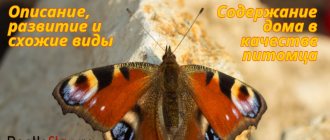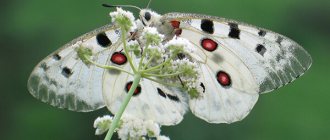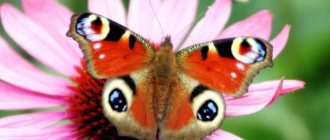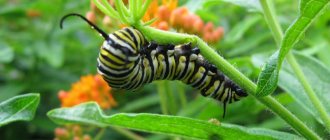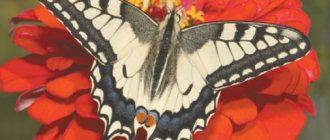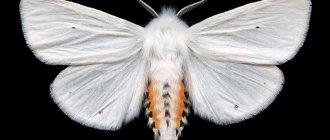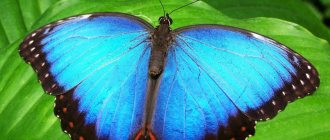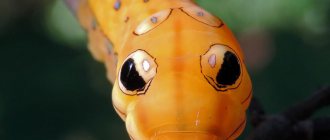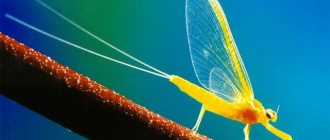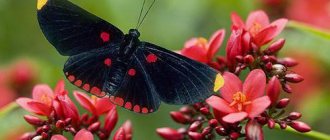The Mnemosyne butterfly looks very similar to the malicious garden pest - the cabbage white butterfly, and a female at that. If you don’t look closely, they can be easily confused, although even biologically they belong to different families.
The inhabitant of the Red Book, unlike the cabbage lover, does not have such intense coloring of the tips of the fore wings. On the contrary, in these places there is no coloration at all, and the wing seems to be glassy, which is clearly visible in the photo of the Mnemosyne butterfly.
Insects of the Red Book
Currently, about a million insects are known. Most likely, there are many more of them, but man has not yet been able to describe all of them. This is the most numerous class of animals, striking in the diversity of its species. In Russia their number is 80-100 thousand.
In most cases, insect extinction is associated with human activity. The main reasons for insects being included in the Red Book are the destruction of their habitat and the use of chemicals that kill them.
With the development of industry and agriculture, people drain swamps, change river beds, and destroy forests. Disruption of the natural landscape makes changes to the usual course of life in the area; animals are deprived of food resources and places to build homes.
The most unpretentious insects, for example, those that feed on various types of food (monophages), adapt to new conditions. Oligophages have very limited food preferences, so they may die.
There are 95 species of insects in the Red Book of Russia. They include the orders Orthoptera, Lepidoptera, Dragonflies and Hymenoptera. Species whose numbers are declining include: Emperor dragonfly, two-spotted aphodia, some woodcutter beetles, hermits, many ground beetles, stag beetles, blueberry butterflies, alfalfa, etc. Endangered insects listed in the Red Book are: Pacific marshmallow, Kochubey's Ribbon, Mongolian bear, warty omias and others.
Orthoptera
Grasshoppers
Eastern sawtail
Status 3 category.
Sawtail
Settles in mixed-grass meadows, forest edges and clearings.
Found in the southern part of Udmurtia. Located on the northern edge of the habitat. To increase the number of species, work must be carried out to identify habitats and assign them the status of specially protected natural areas.
Stag beetle
The stag beetle is a large and not too rare insect in our area, but their numbers are gradually declining. On average, adults reach up to 7 centimeters in length; some individuals grow up to ten centimeters. In Russia it is the second largest beetle. It lives in deciduous forests, preferring oaks, but can be content with other species. The main limiting factor for it is uncontrolled deforestation.
First of all, it is known for its huge “horns”, which is why it got its name. In fact, these are the upper oral jaws, mandibles, which they often use to fight other males and attract females. Female beetles have much smaller jaws and are almost invisible.
Behavior in nature
Because Swallowtails become active as daylight approaches, they have access to many colors. These large butterflies need a lot of nectar, so they can often be found in various parks and gardens.
Males are territorial insects. They choose their personal space at a dominant height. They are also no strangers to gathering in small groups, sitting on the shores of bodies of water. All individuals tend to sit on hills and tall trees. Many Swallowtails flutter at heights and show their peculiar up-and-down dance.
In nature, it is almost impossible to catch a Swallowtail at rest with all its wings spread, since the hind wings are invisible against the background of the front ones. Swallowtails can fully spread their wings when exposed to warm, bright sunlight.
Wax bee
In appearance, the bee is very similar to the honey bee, but is slightly smaller in size. An adult grows to 10-12 mm. The wax bee is an endangered insect. Amateur beekeepers cause great damage to them. One wax bee nest produces up to 40 kilograms of honey, but when it is removed, the insects are often exterminated.
The species is found in China, Japan, Korea and northern China. In Russia, it is distributed only in coniferous and broad-leaved floodplain forests of the Primorsky Territory. They live in hollow trees and holes in rocks. To prevent the bees from disappearing completely, they are protected in the Kedrovaya Pad and Ussuriysky parks.
Interesting Facts
There are several noteworthy facts related to mnemosyne butterflies:
- The writer Vladimir Nabokov, one of whose hobbies was collecting butterflies, dedicated poetry to the black Apollo.
- In some countries it is believed that if you see three Mnemosyne butterflies at the same time, some happy event will soon occur.
- Corydalis plants are also taken under protection as a food source for mnemosynes.
At the end of the conversation, we invite you to watch a video about the Mnemosyne butterfly.
Gebler's ground beetle
Gebler's ground beetle is an extremely rare insect. In Russia, there has been no reliable evidence of its discovery for half a century. The last time the animal was found was near Zmeinogorsk. It settles in the bushes of valleys and foothills, in mixed and small-leaved forests. It is also found in the eastern part of Kazakhstan.
The ground beetle reaches only 3-4 centimeters. It has a black head, but the rest of the body segments can be of different colors: from bronze to blue-black or green-black. A light line borders the edges. This is a predator whose “menu” is very diverse and is represented by small insects.
How long do butterflies live?
How long do butterflies live? It is difficult to say something specific, because there are a lot of different species and each species, having its own characteristics, has a different life expectancy. But generally butterflies live from several days to several weeks.
If we talk about the pupa, then there is a slightly different life span.
The butterfly lives in the pupa for 2 to 3 weeks. But some species hibernate during the winter and, accordingly, remain in the pupa longer.
Blueberry oreas
The amazingly beautiful oreas butterfly is endemic to the Far East. It is found only in this region, in the south of Primorye. They live near river banks, in mixed forests and bushes. The insect is listed in the Red Book as an endangered species.
They are colored violet-bluish, and the upper edges of the wings are outlined with a black outline. On the underside the color is much lighter, in gray shades with a bluish tint closer to the body. There are also black spots on the wings. In flight, their span reaches 30 centimeters. Oreas butterflies are very dependent on the plant Prinsepia sinensis, as their caterpillars feed only on it. Deforestation and livestock grazing reduce its number, which is why the number of insects also decreases.
Reproduction and lifestyle
The Mnemosyne butterfly has a rather interesting lifestyle; for example, a fully formed caterpillar, but not hatched from an egg, spends the winter with the insect. With spring warming in nature, in April-May, depending on the region, the larvae emerge from the eggs and begin to feed on the leaves of the corydalis.
Our help! Adult butterflies also largely feed on corydalis, sucking nectar from their flowers.
The appearance of the caterpillars is quite bright: a black body with bright yellow spots. These marks are located in two parallel lines along the body of the larva.
This is interesting! While mnemosyne butterflies lead an exclusively diurnal lifestyle, caterpillars only come out to feed at night. They wait out the daylight hours, burrowing into the leaf litter.
Having gained sufficient size and weight, the black Apollo caterpillar pupates, settling under the litter for the duration of this stage. In a dense cocoon on the soil, the transformation into an adult occurs.
The butterflies emerge around the beginning of July, with a shift of a couple of weeks in both directions. After mating, another feature of this species appears: the female’s reproductive tract is sealed with a protein plug. So nature protected her from re-fertilization by another male.
After some time, the female black Apollo lays about forty eggs on the underside of the leaves of the corydalis. The development of caterpillars lasts almost until the onset of stable cold weather, after which the insect enters the stage of suspended animation until spring.
Relic Lumberjack
These long-haired beauties are the largest beetles in Russia. In the Red Book, the insect has the status of a species with declining numbers. They are found in deciduous and mixed forests of the Primorsky and Khabarovsk Territories, as well as in China.
The woodcutter grows to 8-10 centimeters and has long mustaches, half the size of the body. It has a black head and paws, and chestnut elytra. Its body is very elongated, which makes the mustache not look as impressive as that of related species.
This relict beetle got its name from a characteristic feature. Lumberjack larvae develop inside dying trees, and they often infect them with fungi that contribute to the destruction of the wood. Other related beetles, for example, sky longhorned beetles, may also live near them. They have a bright turquoise color with large black spots and are also listed in the Red Book.
Lifestyle of a butterfly
Butterflies are very fragile. During their short life, they must have time to lay eggs, so they try to defend themselves in various available ways.
Some butterflies are difficult to spot due to their coloring. They blend into the surrounding nature and if you don’t look closely, you can pass by.
There are butterflies that protect themselves with poisonous wings. Judging by their colors, one can often assume that they are poisonous and should not be touched. This is done to protect against birds, because even if a bird eats one butterfly, this will not happen again next time. After eating poisonous butterflies, birds begin to vomit and their heart may stop. But at the same time, poisonous butterflies are very beautiful.
Appearance
Together with the urticaria and lemongrass, the admiral belongs to the same family of nymphalids. The front wings usually have several white spots of varying sizes. The hind wings are completely black, with a red border. Up close, you can easily notice that this black is not at all uniform, but consists of many different shades flowing into each other.
The admiral is a medium-sized butterfly with a wingspan of up to 6.5 cm. The wings are almost triangular, but wavy along the outer edge. In some places you can see small bluish inclusions. Thanks to this coloring, an admiral with folded wings is almost impossible to notice in a tree or on the ground.
The antennae are black, but with white rings along their entire length. The proboscis is long and curled when at rest. The segmented legs consist of five parts, with the short front ones not participating in movement. The butterfly's abdomen is brown, brown or black. Males and females differ little from each other.
Photo: pixabay.com
